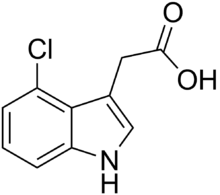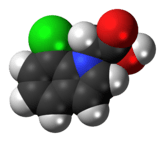4-Chloroindole-3-acetic acid
4-Chloroindole-3-acetic acid (4-Cl-IAA) is an organic compound that functions as a plant hormone.[1]
 | |
 | |
| Names | |
|---|---|
| Preferred IUPAC name
(4-Chloro-1H-indol-3-yl)acetic acid | |
| Other names
2-(4-Chloro-1H-indol-3-yl)acetic acid | |
| Identifiers | |
3D model (JSmol) |
|
| ChEBI | |
| ChEMBL | |
| ChemSpider | |
| ECHA InfoCard | 100.255.860 |
PubChem CID |
|
CompTox Dashboard (EPA) |
|
| |
| |
| Properties | |
| C10H8ClNO2 | |
| Molar mass | 209.63 g·mol−1 |
Except where otherwise noted, data are given for materials in their standard state (at 25 °C [77 °F], 100 kPa). | |
| Infobox references | |
Synopsis
It is a member of the class of compounds known as auxins and a chlorinated analogue of the more common indole-3-acetic acid (IAA) auxin. 4-Cl-IAA is found in the seeds of a variety of plants, particularly legumes such as peas and broad beans.[2][3][4][5] In one study it is written that the substance is "mainly found in reproductive structures" and "is thought to be restricted to members of the leguminous tribe Fabeae, specifically "the genera Vicia, Pisum, Lathyrus, Lens, and Vavilovia".[6] In Pisum sativum, 4-Cl-IAA biosynthesis diverges from IAA biosynthesis when the amino acid tryptophan is chlorinated to form 4-chlorotryptophan (4-Cl-Trp); the biosynthesis of 4-Cl-IAA then precedes parallel to that of IAA.[7]
Engvild hypothesized in 1996 that 4-Cl-IAA may be a "death hormone" that maturing seeds use to trigger death of the parent plant by mobilizing nutrients to be stored in the seed.[8]
Lam et al found the substance in the seeds of Medicago truncatula, Melilotus indicus, and three species of Trifolium.[6]
References
- Reinecke, Dennis M. (1999). "4-Chloroindole-3-acetic acid and plant growth". Plant Growth Regulation. 27 (1): 3–13. doi:10.1023/A:1006191917753. ISSN 0167-6903.
- Pless, Tanja; Boettger, Michael; Hedden, Peter; Graebe, Jan (1984). "Occurrence of 4-Cl-indoleacetic acid in broad beans and correlation of its levels with seed development". Plant Physiology. 74 (2): 320–3. doi:10.1104/pp.74.2.320. PMC 1066676. PMID 16663416.
- Ernstsen, Arild; Sandberg, Goeran (1986). "Identification of 4-chloroindole-3-acetic acid and indole-3-aldehyde in seeds of Pinus sylvestris". Physiologia Plantarum. 68 (3): 511–18. doi:10.1111/j.1399-3054.1986.tb03390.x.
- Katayama, Masato; Thiruvikraman, Singanallore V.; Marumo, Shingo (1987). "Identification of 4-chloroindole-3-acetic acid and its methyl ester in immature seeds of Vicia amurensis (the tribe Vicieae), and their absence from three species of Phaseoleae". Plant and Cell Physiology. 28 (2): 383–386. ISSN 0032-0781. Retrieved 16 October 2013.
- Magnus, Volker; Ozga, Jocelyn A.; Reinecke, Dennis M.; Pierson, Gerald L.; Larue, Thomas A.; Cohen, Jerry D.; Brenner, Mark L (1997). "4-chloroindole-3-acetic and indole-3-acetic acids in Pisum sativum". Phytochemistry. 46 (4): 675–681. doi:10.1016/S0031-9422(97)00229-X.
- Lam, H. K.; McAdam, S. A.; McAdam, E. L.; Ross, J. J. (2015). "Evidence That Chlorinated Auxin is Restricted to the Fabaceae but Not to the Fabeae". Plant Physiology. 168 (3): 798–803. doi:10.1104/pp.15.00410. PMC 4741347. PMID 25971549.
- Tivendale, N.D.; Davidson, S. E.; Davies, N. W.; Smith, J. A.; Dalmais, M.; Bendahmane, A. I.; Quittenden, L. J.; Sutton, L.; Bala, R. K.; Signor, C. Le; Thompson, R.; Horne, J.; Reid, J. B.; Ross, J. J. (2012). "Biosynthesis of the Halogenated Auxin, 4-Chloroindole-3-Acetic Acid". Plant Physiology. 159 (3): 1055–1063. doi:10.1104/pp.112.198457.
- Engvild, Kjeld C. (1996). "Herbicidal activity of 4-chloroindoleacetic acid and other auxins on pea, barley and mustard". Physiologia Plantarum. 96 (2): 333–337. doi:10.1111/j.1399-3054.1996.tb00222.x.